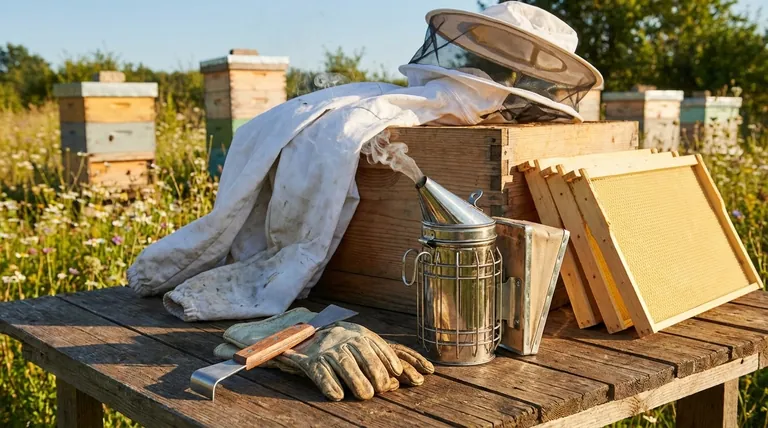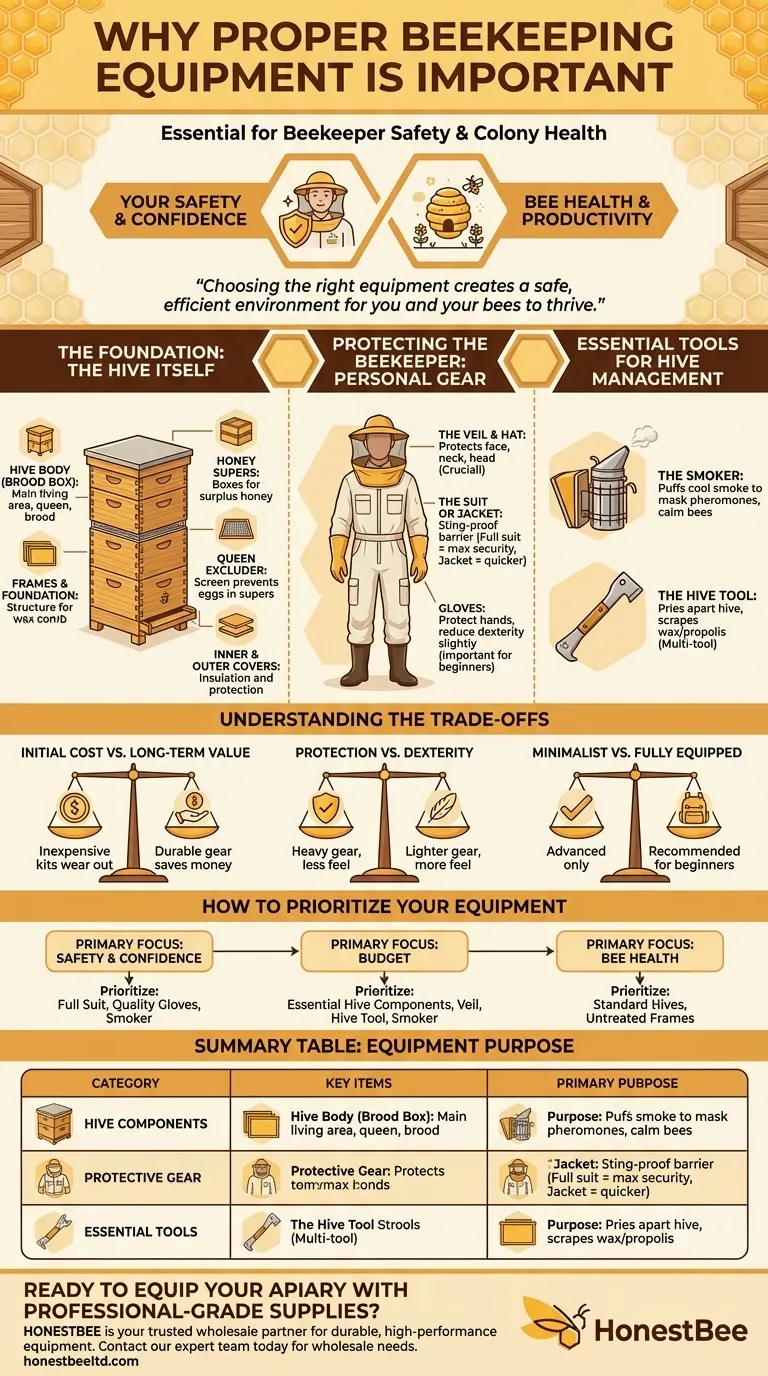Proper beekeeping equipment is essential for two primary reasons: your safety and the health of your bee colony. Using the correct tools and protective gear makes managing a hive less stressful for you and the bees, which directly contributes to a healthier, more productive colony and a more rewarding experience for the beekeeper.
Choosing the right equipment is not merely about acquiring tools; it is about creating a safe, efficient, and low-stress environment that allows both you and your bees to thrive.

The Foundation: The Hive Itself
The hive is the bees' home, and its components are designed to support the colony's natural life cycle while allowing for easy inspection and honey harvesting.
Hive Body and Frames
The hive body (or "brood box") is the main living quarter for the colony. It houses the queen, the brood (eggs, larvae, and pupae), and the initial stores of pollen and honey.
Inside, frames with foundation provide a structure for the bees to build their wax comb, ensuring straight, manageable combs that can be removed for inspection without destroying the hive.
Honey Supers
Supers are smaller boxes placed on top of the hive body. They are specifically intended for bees to store surplus honey.
A queen excluder, a screen with gaps large enough for worker bees but too small for the queen, is often placed between the hive body and the supers to ensure no eggs are laid in the honey-harvesting area.
Inner and Outer Covers
The inner cover provides a dead air space for insulation and has a notch for upper ventilation or feeding. The outer cover, often telescoping and topped with metal, protects the entire hive from rain, snow, and the elements.
Protecting the Beekeeper: Personal Gear
Working with thousands of stinging insects requires respect and proper protection. This gear builds the confidence necessary for calm and effective hive management.
The Veil and Hat
A veil is the single most important piece of protective equipment. It protects your face, neck, and head from stings, which are most dangerous and painful in this area. It is considered non-negotiable for beekeepers of all experience levels.
The Suit or Jacket
A full beekeeping suit or a jacket provides a sting-proof barrier for your body. Jackets offer good protection for the torso and are quicker to put on, while full suits provide complete coverage for maximum security, which is ideal for beginners.
Gloves
Beekeeping gloves, typically made of leather with long gauntlets, protect your hands and forearms. While they reduce dexterity slightly, they are crucial for building confidence and preventing stings as you learn to handle frames and tools.
Essential Tools for Hive Management
Beyond the hive and protective gear, two tools are used in nearly every hive inspection.
The Smoker
A smoker is a small, fire-proof canister with bellows used to puff cool smoke into the hive. The smoke masks the bees' alarm pheromones, preventing a coordinated defensive response and calming the colony during an inspection.
The Hive Tool
The hive tool is the beekeeper's multi-tool. It's a sturdy piece of metal used for prying apart hive bodies and frames that bees have sealed with propolis (a sticky plant resin), as well as scraping away excess wax and propolis.
Understanding the Trade-offs
Making smart equipment choices involves balancing cost, comfort, and function.
Initial Cost vs. Long-Term Value
Inexpensive starter kits can be tempting, but they often include lower-quality woodenware or gear that wears out quickly. Investing in well-constructed hive components and durable protective gear often saves money and frustration in the long run.
Protection vs. Dexterity
There is a direct trade-off between heavy protection and the ability to work delicately. Thick gloves and full suits offer maximum sting prevention but can feel clumsy. As you gain experience, you may opt for lighter gloves to better handle frames and queens.
Minimalist vs. Fully Equipped
Some experienced beekeepers work with minimal gear, such as only a veil. This is not recommended for beginners. Proper equipment allows you to focus on learning bee behavior and hive management without the constant fear of being stung.
How to Prioritize Your Equipment
Your initial purchases should align with your primary goals as a new beekeeper.
- If your primary focus is safety and confidence: Prioritize a full beekeeping suit, quality gloves, and a reliable smoker to ensure your first experiences are positive and low-stress.
- If your primary focus is budget: Begin with the essential hive components, a veil, a hive tool, and a smoker, as these are the absolute must-haves for housing and managing bees.
- If your primary focus is bee health: Invest in well-constructed, standard-sized hive bodies and frames made from untreated wood to provide a stable, healthy, and expandable environment for the colony.
Ultimately, proper equipment is the foundation that enables you to become a responsible and effective caretaker for your bees.
Summary Table:
| Equipment Category | Key Items | Primary Purpose |
|---|---|---|
| Hive Components | Hive Body, Frames, Supers, Covers | Provide a stable, healthy, and expandable home for the colony. |
| Protective Gear | Veil, Suit/Jacket, Gloves | Ensure beekeeper safety and build confidence during hive inspections. |
| Essential Tools | Smoker, Hive Tool | Calm bees and manage hive components efficiently. |
Ready to equip your apiary with professional-grade supplies?
HONESTBEE is your trusted wholesale partner, supplying commercial apiaries and beekeeping equipment distributors with durable, high-performance equipment designed for safety, efficiency, and long-term value. From complete hive systems to essential protective gear, we provide the tools you need for a thriving operation.
Contact our expert team today to discuss your wholesale needs and discover how we can support your success.
Visual Guide

Related Products
- Professional Dual-End Stainless Steel Hive Tool for Beekeeping
- HONESTBEE Advanced Ergonomic Stainless Steel Hive Tool for Beekeeping
- Beehive Handle and Frame Rest Cutting Machine: Your Specialized Hive Machine
- Professional 3-Bar Frame Grip with Integrated Hive Tool
- Professional Galvanized Hive Strap with Secure Locking Buckle for Beekeeping
People Also Ask
- What should beginners consider when purchasing beekeeping equipment? A Guide to Essential Starter Gear
- What are the features of a regular hive tool? The Essential Multi-Tool for Every Beekeeper
- What is a hive tool used for in beekeeping? Your Essential Guide to Hive Management
- What are the basic tools for beekeeping? Essential Starter Kit for Safe & Successful Hive Management
- What temperature is too cold to open a beehive? Protect Your Hive from Fatal Cold Shock



















